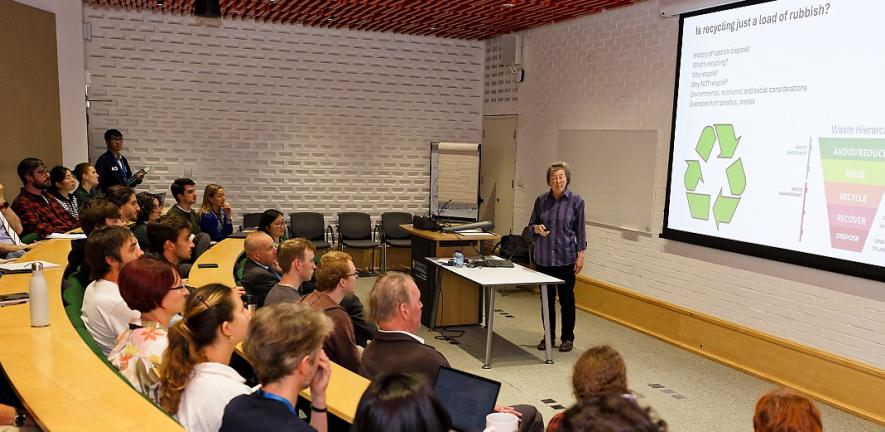
Dr Barlow – a sustainability and materials engineer and Fellow Emerita at Newnham College – delivered a thought-provoking talk titled “Is recycling just a load of rubbish?” . Her talk highlighted how the composition of waste has changed dramatically over time. In the past, much of the UK’s waste consisted of ash and cinders from fires, hence the term "dustmen." During the Second World War, shortages made people more resourceful—reusing and salvaging more, with less thrown away. But as post-war affluence grew, so did the ‘throw-away’ culture of convenience and disposability, especially in packaging, which remains one of today’s biggest recycling challenges.
Recycling became more formalised from the 1960s, with legislation such as the European Packaging and Packaging Waste Directive in 1994 starting to drive behavioural change. Recycling targets continue to ramp up, but there are economic, technical and social challenges in meeting them. Even the well-established, effective and environmentally beneficial system of “like-to-like” recycling that turns used milk bottles and clear plastic drinks bottles into new bottles is economically fragile.
Dr Barlow shared her experience with the Plastics to Ghar project in a remote Himalayan village in Nepal, where plastic waste is transformed into useful items like floor tiles. This local, community-based initiative demonstrates how recycling can deliver real environmental, economic and social value.
Dr Barlow nevertheless emphasised the limitations of recycling, highlighting plastic packaging as a key example. Often made from complex polymers, such packaging is designed to preserve food and reduce waste, yet it remains notoriously difficult to recycle. She urged that packaging be assessed within the broader context of the entire system: the carbon footprint of packaging is generally minimal compared to that of food production itself. As an example she cited cheese packaging, a multi-layer plastic film with a very small environmental footprint which reduces food wastage by enabling a shelf life of months rather than a few days. However, the film is not easily recycled, and replacing it with more recyclable materials results in a bigger carbon footprint.
Importantly, Dr Barlow stressed that recycling sits low on the waste hierarchy. Ideally, the priority should be to avoid producing waste altogether and secondly on reusing what we already have. Recycling, she warned, can be expensive, technically challenging, and may offer a false sense of progress if it distracts from deeper issues like over-consumption and over-production.
Nevertheless, she concluded that recycling still has a vital role to play, alongside smarter material design, technical advances in recycling processes, policy changes, improved waste management, and shifts in public behaviour. The importance of uniform regulations and clear instructions has been recognised in the introduction of a new four-bin waste system, which will over the next few years be rolled out to all domestic and municipal premises in England.
Her talk was a timely reminder that while recycling is not a silver bullet, it is a necessary part of a broader and more sustainable approach to how we manage waste.
Many thanks to Dr Barlow for a rich and thought-provoking session.
Dr Barlow is always happy to be contacted for more information: cyb1@cam.ac.uk.
The text in this work is licensed under a Creative Commons Attribution-NonCommercial-ShareAlike 4.0 International License. Images, including our videos, are Copyright ©University of Cambridge and licensors/contributors as identified. All rights reserved.
![]()

